The Risk Theatre Model of Tragedy
Gambling, Drama, and the Unexpected
- 2019 INDIES Finalist
- Finalist, Performing Arts & Music (Adult Nonfiction)
The Risk Theatre Model of Tragedy is a piquant, far-reaching study of tragedy as an art form.
Defining the nature of theatrical tragedy is a formidable task; everyone from Aristotle to Nietzsche has taken a crack at it. In his stimulating The Risk Theatre Model of Tragedy, Edwin Wong posits a fresh approach based upon the modern ups and downs of the stock market.
Tragedy, the book argues, can be seen as the ultimate in risk theory. Overconfident or desperate heroes make calculated gambles, resulting in unexpected, high-consequence results. In this wide-ranging treatise, Wong analyzes dozens of examples, from Oedipus Rex to Death of a Salesman, to find compelling evidence that explains why certain tragedies have more lasting power than others.
The study focuses on the structure, philosophy, and poetics of tragedy. This risk theory is at its most convincing when it comes to structure, noting that the genre is characterized by three movements: the protagonist encountering temptation; a wager on a favorable outcome (most often involving life and limb); and a metaphorical cast of the dice, in which the protagonist makes his gamble and endures the subsequent results. In modeling this, supporting references and plot points are pinpointed from classic tragedies. The book further delineates different approaches, from “frontloaded” variants (which begin with a bang and end with introspection) to “backloaded” versions (in which cataclysmic outcomes are saved for the climax).
Tragedies are further segmented by their scope (involving a single hero and “risk event,” or a series of unfortunate events ensnaring numerous characters). Fascinating side topics, including the invention of the concept of money and how it led to tragedies being boiled down to the price of life itself, are covered, and the book invites consideration of the commonplaces of tragedy, from the supporting characters who influence protagonists’ decisions to the influence of the supernatural. This work moves toward a final comparison of tragedy with other major genres and disciplines that demonstrates how they also reflect the human condition.
Such analyses run the risk of being dry, but this is engaging work. It pulls passages from classic plays in a generous way and serves as a fun primer on tragedies in general, as well as a bracing presentation of its theories. Ranging musings tap into heliocentric theories of the universe, historic disasters such as the French Maginot Line in World War II, and how the action in a tragedy mirrors the second law of thermodynamics. These heady detours don’t always cohere with the book’s grand theories, but their multidimensional approaches are lively and thought-provoking.
Making the case for risk theory as a new definition for tragic theater, The Risk Theatre Model of Tragedy is a piquant, far-reaching study of tragedy as an art form.
Reviewed by
Ho Lin
Disclosure: This article is not an endorsement, but a review. The publisher of this book provided free copies of the book and paid a small fee to have their book reviewed by a professional reviewer. Foreword Reviews and Clarion Reviews make no guarantee that the publisher will receive a positive review. Foreword Magazine, Inc. is disclosing this in accordance with the Federal Trade Commission’s 16 CFR, Part 255.

